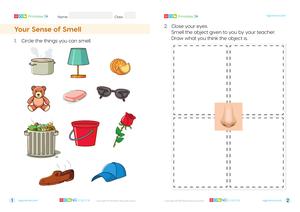Begin the lesson by introducing the sense of smell as one of the five senses. Discuss how the nose is the primary organ for detecting smells.
Go to the LessonLearning Objectives
- Identify the nose as the sense organ for smelling.
- Recognize different smells as pleasant or unpleasant.
- Describe how the sense of smell is used in daily activities.
Introduction and Hook
Engage students by asking them to share examples of smells they encounter daily, such as food, flowers, or other familiar scents.
Direct Instruction
Explain how the sense of smell works and its importance in daily life. Use simple language and examples that are relatable to young children.
Guided Exploration
Conduct a classroom activity where students identify and categorize different smells as pleasant or unpleasant using items like flowers, fruit, or vinegar.
Hands-On Activity
Organize a 'smell test' where students close their eyes and identify various scents from items like oranges, soap, or spices. Discuss their observations.
Independent Practice
Encourage students to keep a 'smell diary' at home, noting different smells they encounter and categorizing them as pleasant or unpleasant.
Check for Understanding
Ask students to share their findings from the 'smell diary' and discuss how the sense of smell helps in daily activities.
Review and Reflection
Review the key points of the lesson, emphasizing the role of the nose in detecting smells and the importance of the sense of smell.
Assessment and Extension
Use the assessment 'Your Five Senses' to evaluate students' understanding of the sense organs and their functions.
Encourage students to explore other senses and how they interact with the sense of smell in activities like cooking or gardening.
Try the Quiz



